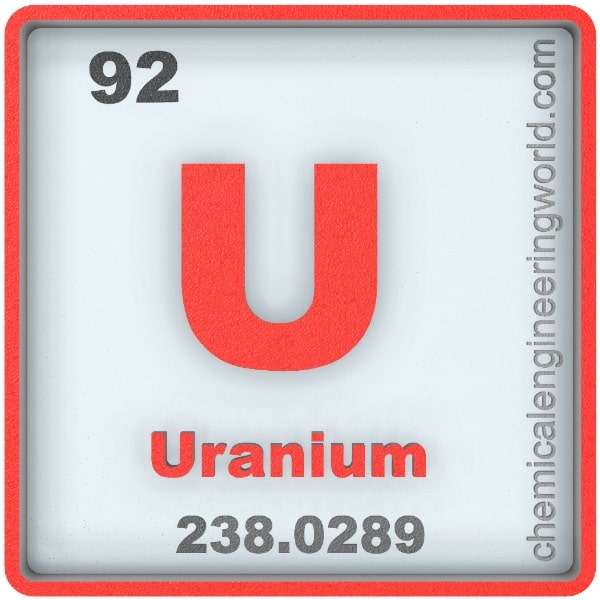Uranium Element Properties and Information

Uranium Element Properties and Information
Uranium is 92nd element on the periodic table. Elements are arranged in the periodic table on the basis of the atomic number. Atomic number is the number of protons in the nucleus of the atom. Uranium has an atomic number of 92. It is located in the Group ‘Actinides’ and Period 7 of the periodic table of elements. It is denoted by the symbol ‘U’. The name is derived from the planet, Uranus.
Mineral called ‘Pitchblende’ had been turning up in silver mines since Middle Ages. This mineral was investigated by Martin Heinrich in 1789; he dissolved it in nitric acid and obtained a yellow colored oxide precipitate. He realized later that it was oxide of a new metal.
Uranium is always found combined with other elements; its concentration of uranium in Earth’s crust is 2-4 ppm. Uranium is 51st most abundant element present on Earth: it is the highest-numbered element which is found naturally in significant quantities on Earth. Uranium is found in little quantities in all types of rock, soils, and waters; the minerals in which it is found in abundance are uranite (pitchblende), carnotite, and brannerite.
Physical Properties
- Uranium is a metal in actinide series which is silvery-white in appearance.
- The atomic mass of uranium is 238.03.
- The melting point of uranium is 1132°C.
- The boiling point of uranium is 3818°C.
- The density of uranium is 18950 in S.I. units at 20°C.
- Uranium is slightly paramagnetic in nature.
- Uranium is malleable and ductile but hard enough to scratch a glass.
- Uranium is a poor conductor of electricity.
- Uranium-235 is the only fissile isotope; other naturally occurring isotopes are fissionable but not fissile.
Chemical Properties
- Uranium forms a dark-color layer on its surface when exposed to air.
- Uranium metal reacts with almost all non-metals and their compounds.
- Uranium is a strongly electropositive metal.
- Uranium gets dissolved easily in nitric acid and hydrochloric acid. Non-oxidizing acids attack the uranium very slowly.
- Finely divided uranium reacts with the cold water.
Methods of Production
- Leaching: The ore is first crushed properly and then subjected to leaching via acids or alkalis. Concentration is then done by either of the process of solvent extraction, precipitation, or ion-exchange which yields a yellow-cake which contains 75% of uranium oxides. Calcination further removes the impurities and then the product is refined.
- Reduction: Uranium metal is obtained by reducing uranium halides with alkali or alkaline earth metals.
- Electrolysis: The electrolysis of uranium tetrafluoride dissolved in sodium chloride yields uranium metal.
- Decomposition: Heating uranium halide on a hot filament produces highly pure uranium.
Relevance in Chemical & Related Industries
Food industry: Irradiation of the food materials, during processing stage, with uranium radio-isotopes kills parasites, bacteria, and pests.
Relevance in Other Industries
- Military: Depleted uranium is used as a penetrators and shielding materials.
- Nuclear Power Plants: Under the assumption of complete fission, 1 kg o furanum-235 produces 20 terajoules of energy. The energy is equivalent to 1.5 million kg of coal.
Health Effects on Exposure
- Large-dose: Exposure to uranium is large dose can cause kidney disease.
- Radionuclides: Exposure to uranium radionuclides, which are formed during radioactive decay, causes cancer.
Effects on Exposure
- Accumulation: Uranium is very reactive so if it starts accumulating in the soils then it will tend to not move for many years.
- Plants: Plants absorb uranium through roots and store it there, if the soil is very rich in uranium then the root vegetables and plants tend to be high in uranium content.
References:
https://en.wikipedia.org/wiki/Uranium
































